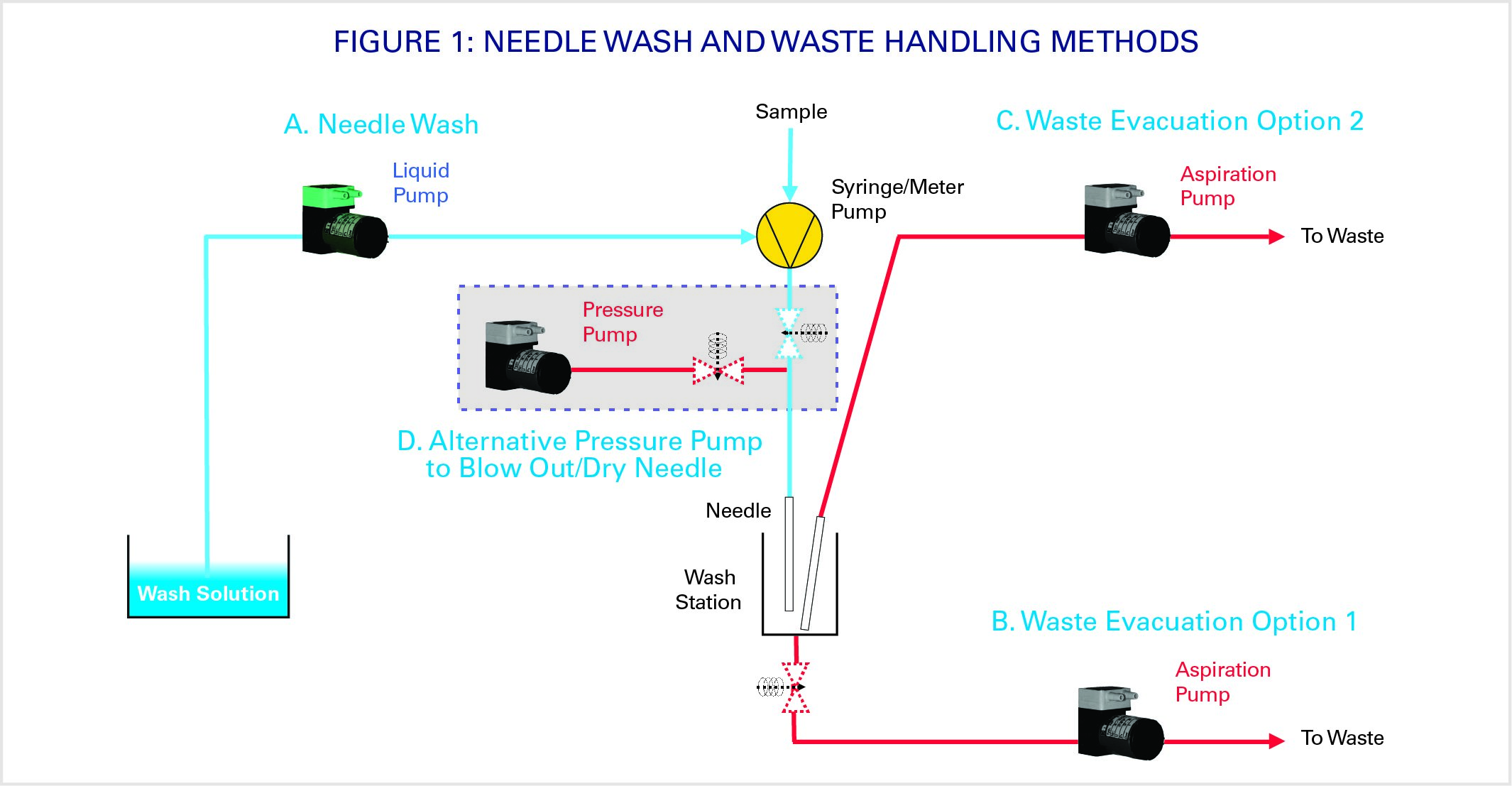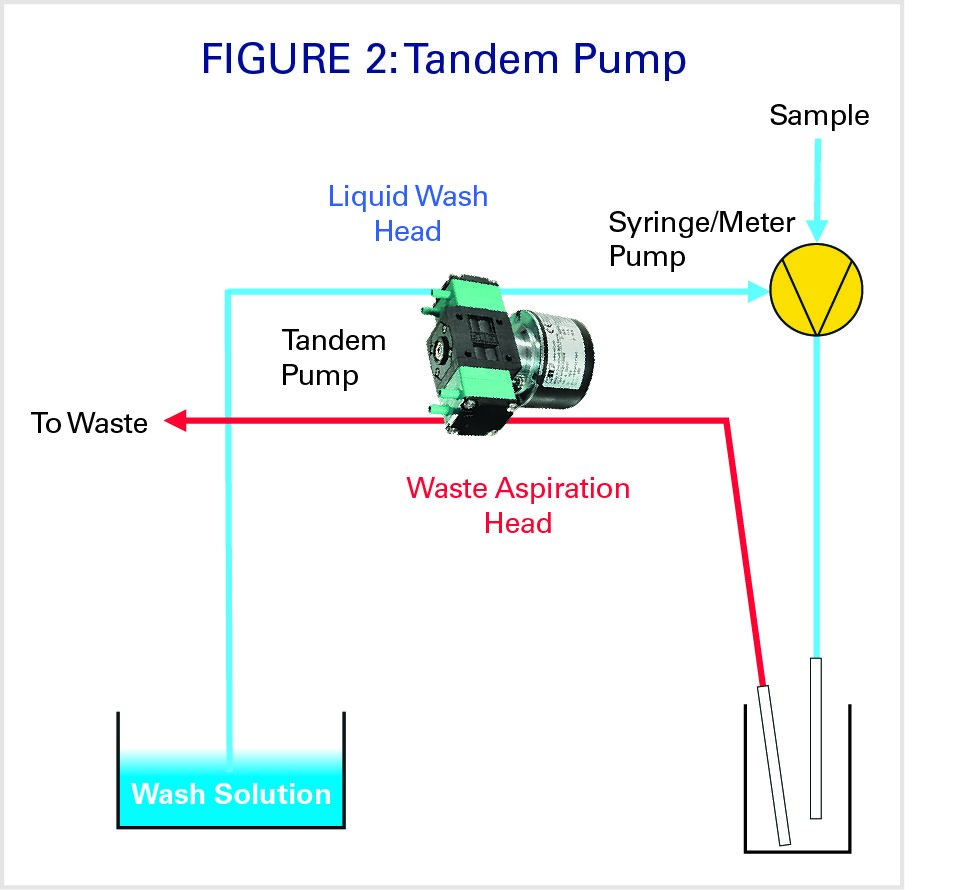Syringe-type needles are commonly used to meter or dose liquid samples onboard clinical diagnostic and analytical lab equipment. These needles must be washed after each use to avoid cross-contamination with the next test. Needle washing has long been a successful application for diaphragm pumps. This article explores different methods, pump types and popular options to consider, and offers suggestions for process optimization. In addition, other system components, such as cuvettes and microtiter plates, can be washed with similar approaches.
Washing the needle
The typical needle wash process involves forcing DI water, solvent, surfactant (soap solution), sodium hypochlorite (NaClO), or other liquid through a needle that is positioned inside a wash station (volume ~10 to 25 mL open-top well; 5 to 50 mL of liquid typically consumed).
Starting with the basics, only the tip of the needle is actually in contact with sample, so cross-contamination is concerned mainly with that portion of the needle. After the sample is dispensed into a well or other device, the needle is moved to a wash station where it is inserted into a cup. Cleaner is pumped through the needle from the top at a rather high speed, taking any leftover sample out the tip and into the cup. After the cleaner is pumped through the needle it accumulates in the cup and the liquid level in the cup rises, thus cleaning the outside of the needle. Sometimes, the geometry of the well is specially designed to enhance the swirling action of the wash fluid, resulting in a better cleaning.

Figure 1
Next, a valve is opened to the vacuum line, and the liquid waste is aspirated from the cup into the main waste container. After a specific amount of flushing time, the cleaner fluid is stopped, and DI water, a buffer liquid, or air is pumped through the needle to carry out any leftover liquid and dry the inside, again from the top to the tip. Meanwhile, the vacuum line continues to aspirate the waste air/ liquid slurry mixture.
∆P and suction duration should be optimized to assist needle drying after all liquid has been removed. Alternatively, some systems incorporate a separate pump to blow air over/through the needle to aid drying.
The needle is never in contact with any hard surface, liquids only, so the X-Y-Z table positions it in the proper location to draw sample, dispense it, and then wash it without ever touching any other component.
Why a diaphragm pump?
Diaphragm pumps are the most popular choice for both wash and waste removal functions. Reasons include:
- · Ability to handle liquid/air mixtures
- · Chemical compatibility
- · Self-priming ability
- · Long service-free lifetime
- · Good vacuum for suction
- · Ease of adjustability to accommodate a wide and varying range of flow rates
Other pump types, such as peristaltic, gear or centrifugal may be used, but include limitations and tradeoffs that must be accommodated.
Pump optimization configurations
Different materials? Standard wetted materials are Polypropylene (PP) and Ethylene Propylene (EPDM) that are compatible with most wash fluids. Many other materials including PVDF, PTFE and FFPM are readily available.
Higher pressure? Pump pressure output is typically ~1 bar gauge (14.5 psig). It may be desirable to increase the pressure output to increase the cleansing action, allow for smaller ID tubing, or possibly reduce the amount of wash fluid consumed. High-pressure versions can provide the ability to operate continuously for a long lifetime at a much higher psig.
Overpressure safety recirculation? If pressure downstream of the pump increases for whatever reason (blockage, narrow restriction, etc.), a recirculation feature, like the one on KNF pumps designated .27, provides safety for the pump and system. This option is field or factory adjustable to open and even run continuously at set pressures from 1 bar gauge (14.5 psig) to greater than 6 bar gauges (87 psig)

Figure 2
Tandem pump? Some systems use a dual-headed pump where one head is for needle wash and the other is for waste transfer. This approach makes sense since both functions are performed nearly simultaneously. The waste pump flow rate must be greater than that of the needle wash because it will handle the same volume of flow going into the cup, plus a large amount of aspirated air. A single tandem pump is usually smaller and less expensive than two individual pumps.
Speed control? Pump speed may be lowered or even increased to match system requirements, resulting in a longer lifetime for the pump and fluidic components, as well as quieter operation.
Conclusion
While syringe-type needles used for metering or dosing liquid samples pose cross-contamination risks, they are regularly eliminated through proper cleaning. Because protocols differ across applications, it is necessary for laboratory technicians and systems engineers to understand the benefits and limitations of various cleaning methods. Among other considerations, a well-optimized pump configuration should account for needle design, washing solution, and, most importantly, long-term cleaning efficacy. Before the installation of a new cleaning system, it is recommended purchasers consult with a well-regarded pump manufacturer who can guide them through available methods and configurations.




